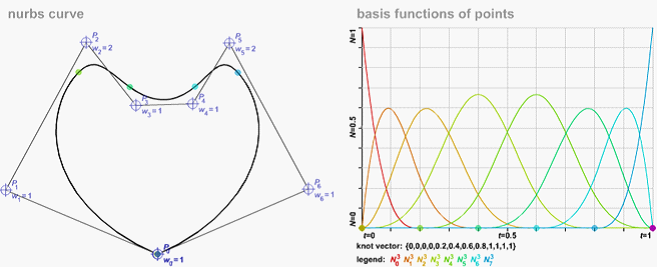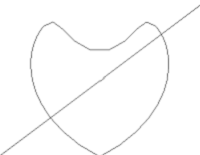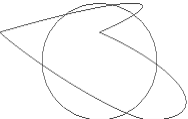
NURBS Curves are lovely and magical, because you can make a lot of interesting shapes from it:

Given two NURBS curves, your task is the find all their intersection points.
If you're not familiar with NURBS curves, here we go:
NURBS is a parametric curve which takes the following form:

Where u is the parameter, n is the number of control points, k is the degree of the curve, Pi and wi are the location and weight of the i-th control point.
The basis function Ni,k is defined recursively below:


Where ti is the i-th knot value. In the formula above, 0/0 is deemed to zero.
To understand the formulae above, here are some brief explanations of the parameters:
Degree. The degree is a positive integer. NURBS lines and polylines are usually degree 1 (linear curve), NURBS circles are degree 2 (quadratic curve), and most free-form curves are degree 3 or 5.
Control Points. The control points are a list of at least degree+1 points. One of easiest ways to change the shape of a NURBS curve is to move its control points[1]. Each control point has an associated number called weight. In this problem, weights are positive numbers. If you increase the weight of a control point, the curve is pulled toward that control point and away from other control points.
Knots. The knot vector is defined as U = [t1, t2, ... , tm]. The relation between the number of knots m, the degree k, and the number of control points n is given by m = n + k + 1[2]. The sequence of knots in the knot vector U is assumed to be non-decreasing, i.e. ti <= ti+1. Each successive pair of knots represents an interval [ti, ti+1) for the parameter values to calculate a segment of a shape. Thus, the whole NURBS curve is defined within [t1, tm). The number of times a knot value is duplicated is called the knot's multiplicity, which should be no more than the degree. Duplicate knot values in the middle of the knot list make a NURBS curve less smooth.
If you're still puzzled after reading all the information above, suppose we're moving u from t1 towards tm (but never reach tm), then the point C(u) will move long the NURBS curve we define.
The first line contains the number of test cases T(T<=25). Each test case contains two parts, one for each NURBS curve. Each curve begins with two integers n and m (2<=n<=20), the number of control points and the number of knots. Each of the next n lines contains three real numbers x, y, w (0<=x,y<=10, 0<w<=10), describing a control point (x, y) with weight w. The next line contains m real numbers, describing the knot vector. The first knot value is always 0 and the last one is always 1. The degree of both NURBS curves will be 1, 2, 3 or 5.
For each test case, print the number of intersection points in the first line, then each point is printed in a following line. The coordinates should be rounded to three decimal places, and points should be sorted lexicographically (i.e. points with smaller x-coordinate comes earlier). Inputs are carefully designed so that the minimal difference of x-coordinate between any two intersection points will be at least 0.005 (otherwise the sorting result might be affected by numerical stability). Print a blank line after each test case.
2 8 12 2 0 1 0 1 1 1 3 2 1.5 2 1 2.5 2 1 3 3 2 4 1 1 2 0 1 0 0 0 0 0.2 0.4 0.6 0.8 1 1 1 1 2 4 0 0 1 4 3 1 0 0 1 1 7 10 1 1.732 1 0 0 0.5 2 0 1 4 0 0.5 3 1.732 1 2 3.464 0.5 1 1.732 1 0 0 0 0.333 0.333 0.667 0.667 1 1 1 7 10 0 1.732 1 2 0 0.5 3 0 1 6 0 0.5 2 1.732 1 6 3.464 0.5 0 1.732 1 0 0 0 0.333 0.333 0.667 0.667 1 1 1
Case 1: 2 (1.029, 0.772) (3.221, 2.416) Case 2: 6 (0.847, 1.092) (1.307, 2.078) (2.283, 2.274) (2.538, 0.133) (2.693, 2.078) (3.153, 1.092)
You may find the data visualizer and additional testdata in the gift package useful. It requires Python and PyOpenGL.
[1] You can try it out: http://geometrie.foretnik.net/files/NURBS-en.swf
[2] In OpenNURBS/Rhinoceros website, m = n + k - 1. The algorithm presented here is referred as "some older algorithms". When solving this problem, please stick to this problem description.
[3] The pictures of the samples are shown below:

